Over the course of most of our 3rd Grade reading comprehension worksheets students will read a short, one-page passage, such as a fun short story or informative piece, and be asked to answer multiple-choice questions about it. There are three sheets for each separate reading passage, so be sure to print them all (we have numbered them to help out). We hope these worksheets help students expand their vocabulary as well as help them start taking an active role in expanding their personal knowledge base. At this level students should begin to look at extended version questions as well as reading longer passages. The worksheet set tries to complement this.
Printable Reading Worksheets for 3rd Graders
Click the buttons to print each worksheet and answer key.

Where Does Chocolate Come From?
Chocolate that we eat starts with cacao trees, also called cocoa trees. Cacao trees grow in a warm climate like Central and South America, Africa or parts of Asia.

Chocolate Multiple Choice Questions
This goes with previous reading passage. Choose the best answer from the four choices over the series of questions.

The Best Garden Helper
Many years ago I moved from the city to the country. One of the first things I did was to make large vegetable garden. It was hard work to change the grassy area to a fine garden.
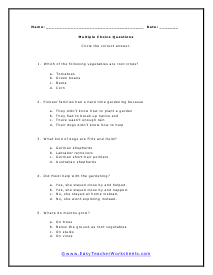
The Best Garden Helper Multiple Choice Questions
What kind of dogs are Fritz and Heidi? Answer a series of questions similar to this based on the reading worksheet above.
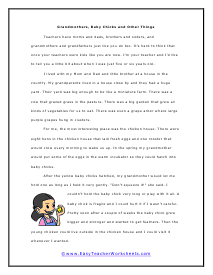
Grandmothers, Baby Chicks and Other Things
Teachers have moms and dads, brothers and sisters, and grandmothers and grandfathers just like you do too.
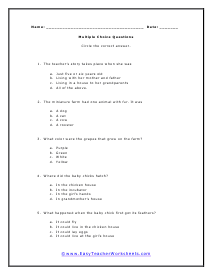
Chick Babies Multiple Choice Questions
You will be asked a wide array of questions about what you read on the previous worksheet. Where does this story take place?

Labrador Retrievers
Do you know which breed of dog is the most popular in the United States right now?
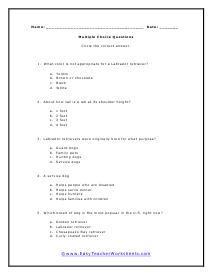
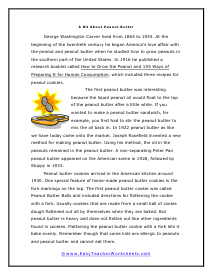
A Bit About Peanut Butter
The first peanut butter was interesting because the liquid peanut oil would float to the top of the peanut butter after a little while.
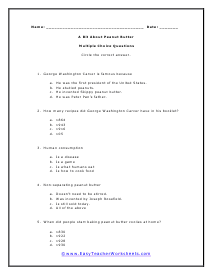
A Bit About Peanut Butter Multiple Choice Questions
How many recipes did George Washington Carver have in his booklet?

The Family Piano
Any member of the family can learn to play the piano. Many talented and famous musicians discovered a love of music sitting at the piano when they were very young. T
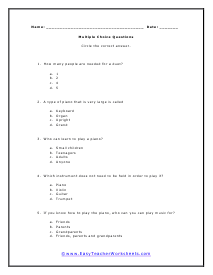
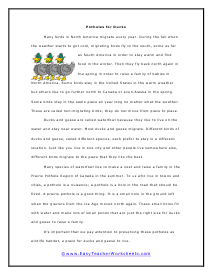
Potholes for Ducks
Many birds in North America migrate every year. During the fall when the weather starts to get cold, migrating birds fly to the south, some as far as South America in order to stay warm and find food in the winter.
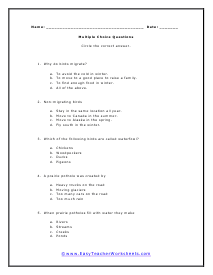
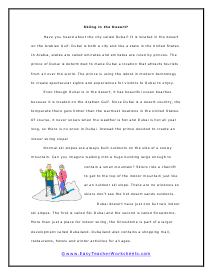
Skiing in the Desert?
Have you heard about the city called Dubai? It is located in the desert on the Arabian Gulf.
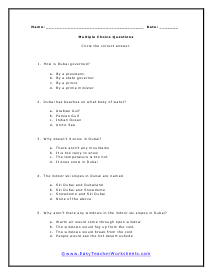
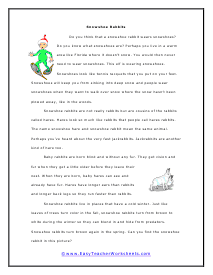
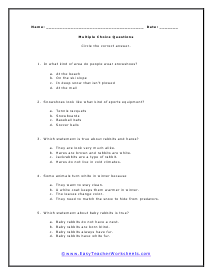
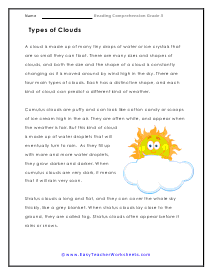
Types of Clouds
A cloud is made up of many tiny drops of water or ice crystals that are so small they can float.
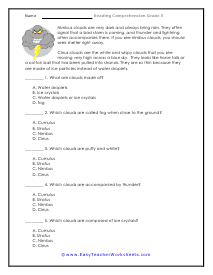
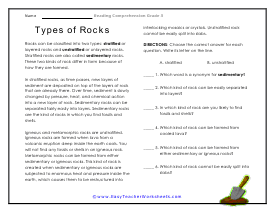
Types of Rocks
In stratified rocks, as time passes, new layers of sediment are deposited on top of the layers of rock that are already there.
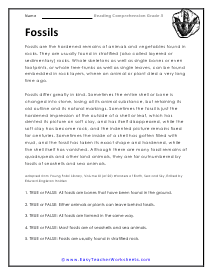
Fossils
We give you a full reading passage and then ask you a series of questions in many different formats based on what you read.
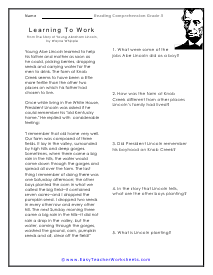
Learning To Work
How was the farm at Knob Creek different from other places Lincoln's family had lived?
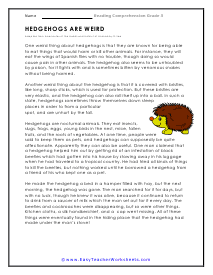
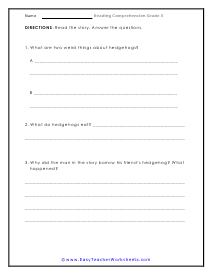
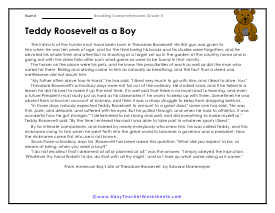
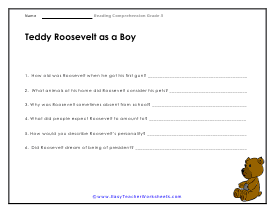
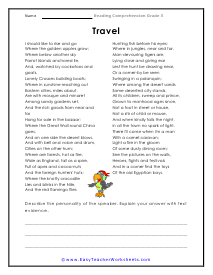
Travel Poem
Describe the personality of the speaker. Explain your answer with text evidence. This is in traditional poem format.
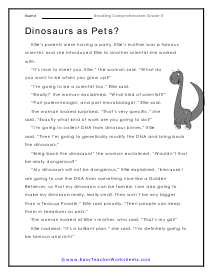
Dinosaurs as Pets?
Ellie's parents were having a party. Ellie's mother was a famous scientist, and she introduced Ellie to another scientist she worked with.
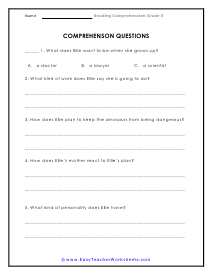
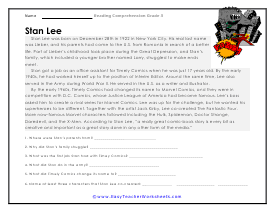
Stan Lee
This reading worksheet is about the life of comic icon Stan Lee of Marvel. I never knew his last name was really Lieber.
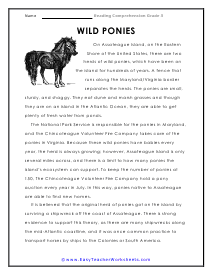
Wild Ponies Passage
It is believed that the original herd of ponies got on the island by surviving a shipwreck off the coast of Assateague.
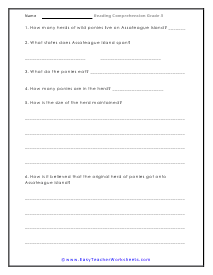
Assateague Pony Question Sheet
It is believed that the original herd of ponies got on the island by surviving a shipwreck off the coast of Assateague.
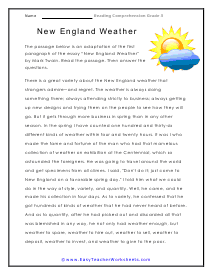
New England Weather Passage
The passage below is an adaptation of the first paragraph of the essay "New England Weather" by Mark Twain.
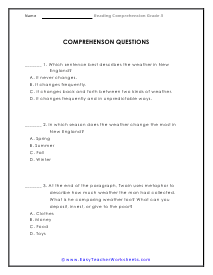
New England Weather Questions
At the end of the paragraph, Twain uses metaphor to describe how much weather the man had collected. What is he comparing weather too? What can you deposit, invest, or give to the poor?
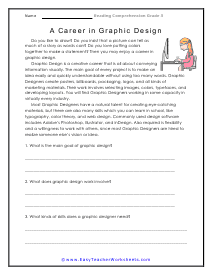
A Career in Graphic Design
Do you like to draw? Do you insist that a picture can tell as much of a story as words can? Do you love putting colors together to make a statement?
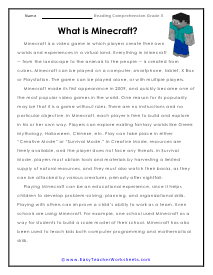
What is Minecraft?
Minecraft is a video game in which players create their own worlds and experiences in a virtual land.
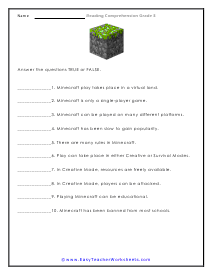
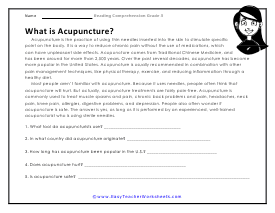
What is Acupuncture?
Most people aren't familiar with acupuncture. Because it uses needles, people often think that acupuncture will hurt.
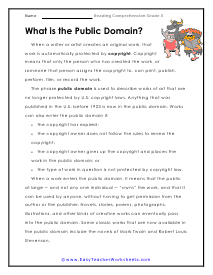
What is the Public Domain?
When a writer or artist creates an original work, that work is automatically protected by copyright.

How to Improve 3rd Grader Reading Comprehension Skills
At the 3rd grade level, we highly suggest that encourage students to read aloud as often as possible. This forces them to slow down and pace how they read passages. This leads to long self-processing time which long term will improve their comprehension of what they read. In order to do this successfully you will need to reassure students that your room is a safe space to read aloud. You will need to work to maintain a positive climate when struggling readers are reading aloud, but after a few behavior corrections, it become the classroom norm. I would also encourage teachers to be included in the reading aloud period. I prefer to start that way the tone is set for the room, but other teachers use this in many different ways. See what works for you. Third grade students should be focused on learning new words, mostly with their decoding skills.
When it comes to learning to read, most kids make significant progress by the end of third grade. But sometimes, despite all the time and energy you've devoted to helping your child improve their reading skills, they still aren't at the level you expect when it comes to reading comprehension.
If your third grader has trouble with reading comprehension, there are things you can do to help them learn how to read better!
1.Let Them Read Aloud
One of the best ways you can help your third grader with reading comprehension is by encouraging them to read aloud. It's common for younger children who are still learning how to decode words-which is especially difficult when learning a new language—not to comprehend what they're reading.
Asking your child to read aloud helps build comprehension skills and provides an opportunity for you to clarify any unfamiliar vocabulary or hard-to-understand passages. Help them decipher tricky words and make predictions based on their knowledge of characters and plots from previous books, movies, or TV shows.
2.Discuss What They Have Read
Whether it's a newspaper or magazine, book, pamphlet, you name it-when kids are reading regularly, they're building their communication skills. That means they learn how to analyze text more effectively.
So instead of limiting how much time your child spends reading, spend more time talking about what they read. Ask them questions (What do you think will happen next? Why did that character make that decision?), have them summarize (in their own words) what happened in a story or chapter, and check for understanding as often as possible.
If a book seems too difficult for your child or he appears uninterested in it altogether, go online and look up some summaries for it-or even watch a movie based on the book!
3.Use Graphic Organizers for Analyzing and Summarizing
The biggest reading comprehension problem for third graders is over-reading. This means kids will read and reread an entire page, not understanding that you don't have to read every word of a passage to understand what's going on. To avoid over-reading, help your child use graphic organizers when she reads. These visual aids help kids break down the text into key points, providing meaning at a glance.
For example, let's say your child is reading about how dinosaurs went extinct. A simple graphic organizer could be a picture of a dinosaur with lines under it indicating climate change, volcanic eruptions, etc. Each line would then lead to another picture or sentence describing each cause.
4.Make Connections Across Texts
Kids read at different levels in school. Many are also required to read from a variety of genres and texts. When you get into later elementary school, most teachers will ask kids not only to report back on what they've read but also how various texts connect with each other.
Rather than simply reading one text after another, kids should make connections between pieces of literature-and then relate those thoughts in their own words. While you can help your child make these connections by posing questions while reading, consider fostering their understanding by discussing published works together. Asking them how two pieces of literature connect is great practice for doing it on their own with more difficult work.
5.Choose Age-appropriate Reading Material
Although reading is fundamental, one-size-fits-all advice doesn't quite work for every child. When choosing books for your third grader, consider how they learn best. Some kids do better with highly structured learning environments and direct instruction. Others find that boring, even if it does help them learn the material more quickly.
If you have a slower learner on your hands, make sure that whatever reading material you choose has plenty of illustrations and visuals so they can be exposed to new words in context. Young children also benefit from a little repetition: read books repeatedly, so they hear their favorite stories multiple times while learning new vocabulary and building background knowledge of key concepts in their subjects.
Ending Thoughts
Kids want to read but struggle with comprehension. If your child is having trouble decoding what they read, start reading together more often and make a conscious effort to talk about what you're reading as you go along, and try incorporating our top tricks!

